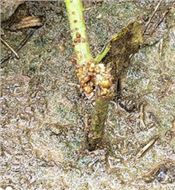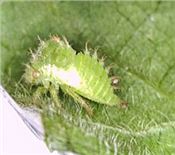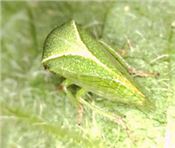|
Threecornered Alfalfa Hopper Found Cutting Soybeans
DR. RAUL T. VILLANUEVA AND GREGORY K. DRAKE
PRINCETON, KY.
In response to the Agriculture and Natural Resources Agent in Butler County (Gregory K Drake), we visited a soybean field that had plants cut off or lodged at 1 to 3 inches above ground (Figure 1). This field, which was planted in late May, was in the V5 growth stage at the time of the visit. The initial thought was to look for cut worms or any insects that perpetrate this type of damage. However, none was found. Five minutes after arriving to this field we had a heavy rain and tallies of insects were not conducted. Based on symptomatology, the insect damage was determined to be caused by threecornered alfalfa hopper. Along with feeding on stems, there were some gall formation on some of the plants (Figure 2).
Description of Pest
This insect gets its name from the triangular body shape of the adult stage (Figure 3a). It is an insect with a large list of hosts; however, they prefer leguminous species. In soybeans, they are considered sporadic pests.
This insect can overwinter as eggs or adults, first feeding in the edges of fields and then moving inside the field. Adults (1/4 inch long) live under plant debris, and when temperatures increase in April or May, eggs hatch and adults became active and start to feed.
The nymphal stage has a very distinctive body shape with saw-toothed spines on the dorsal part of their body (Figure 3b), usually found in the lower parts of plants feeding on the stems. This insect feeds by inserting its piercing mouthparts into stems and sucking sap from leaf petioles, branches and main stem. Feeding usually occurs circling the stem or petiole repetitively, which causes feeding areas to become swollen, and the formation of aerial adventitious roots or galls and calluses (Figure 2). This condition debilitates plants and can cause lodging or breakage in a storm or due to plants’ weight.
As this is a sporadic pest, a threshold has not been well established to control this pest during the vegetative growth. However, cultural practices, such as weed management around soybean fields can be effective to reduce threecornered alfalfa hopper densities.
There is not an established rule for insecticide treatment for hoppers; some studies have shown that treatment should be conducted when 50 percent of the plants are girdled and hoppers are present. Sweep netting is recommended to tally this insect. The sampling should be conducted in different parts of the field. If plants are setting pods, a treatment threshold of 1 threecornered alfalfa hopper per sweep is sometimes recommended. ∆
DR. RAUL T. VILLANUEVA: Entomology Extension Specialist, University of Kentucky
GREGORY K. DRAKE: Agriculture and Natural Resources Agent, Butler County, University of Kentucky

Figure 2. Lodged soybean plant. Notice the callus caused by the feeding of the threecornered alfalfa hopper

Figure 3. (b) Nymphal stage of threecornered alfalfa hopper.
Photos courtesy Raul Villanueva, UK

Figure 1. Soybean plants cut off or logged in Butler Co.
Photo courtesy Gregory Drake, UK

Figure 3. (a) Adult stage of threecornered alfalfa hopper.
|
|